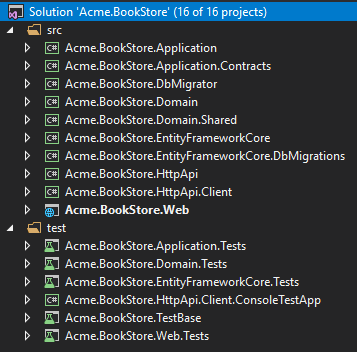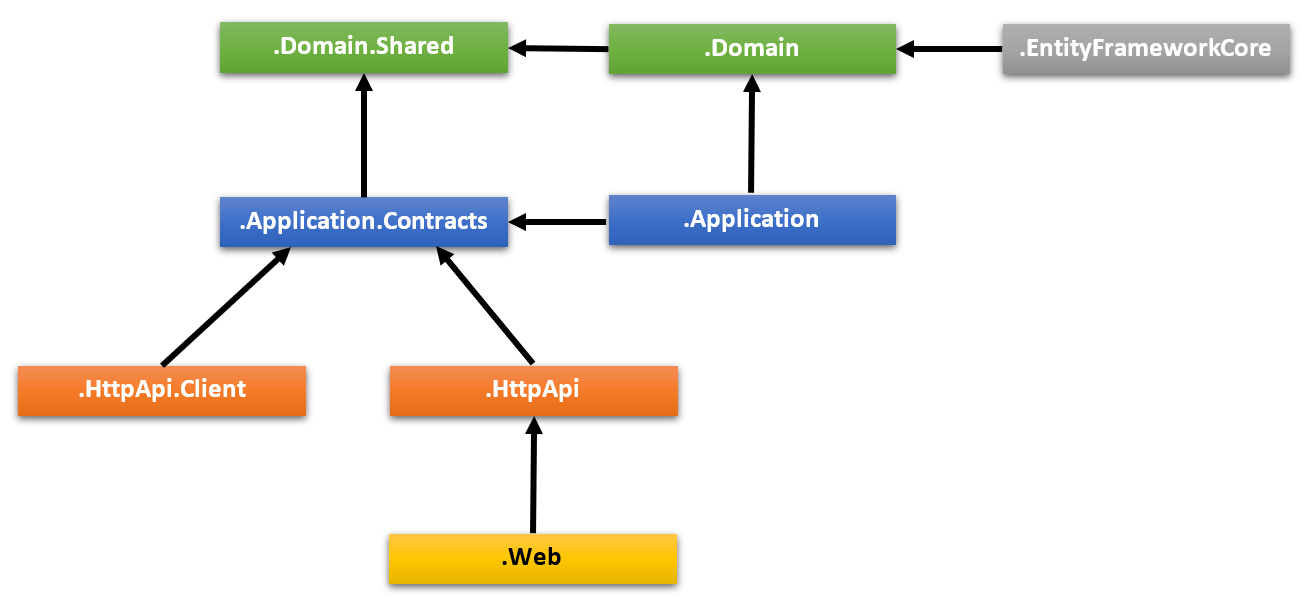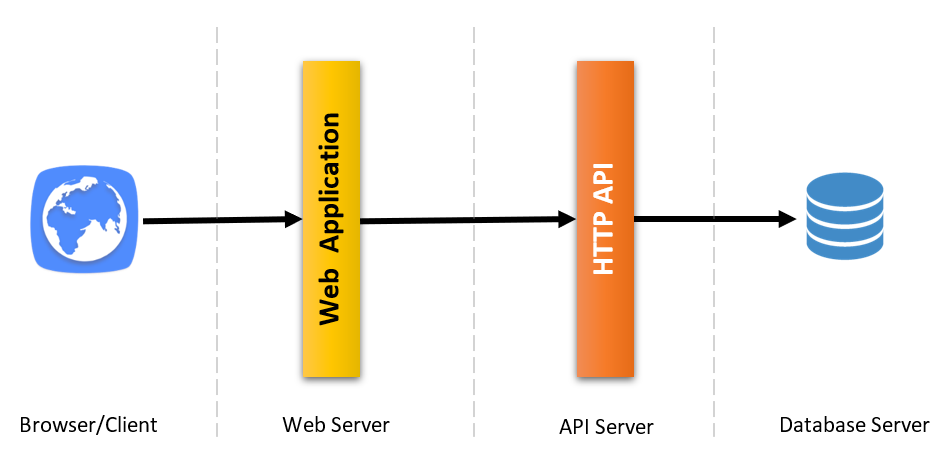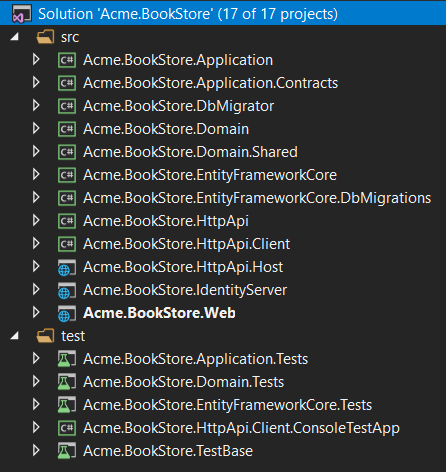Application Startup Template
Introduction
This template provides a layered application structure based on the Domain Driven Design (DDD) practices. This document explains the solution structure and projects in details. If you want to start quickly, follow the guides below:
- See Getting Started With the ASP.NET Core MVC Template to create a new solution and run it for this template (uses MVC as the UI framework and Entity Framework Core as the database provider).
- See the ASP.NET Core MVC Application Development Tutorial to learn how to develop applications using this template (uses MVC as the UI framework and Entity Framework Core as the database provider).
- See the Angular Application Development Tutorial to learn how to develop applications using this template (uses Angular as the UI framework and MongoDB as the database provider).
How to Start With?
You can use the ABP CLI to create a new project using this startup template. Alternatively, you can directly create & download from the Get Started page. CLI approach is used here.
First, install the ABP CLI if you haven't installed before:
dotnet tool install -g Volo.Abp.Cli
Then use the abp new command in an empty folder to create a new solution:
abp new Acme.BookStore -t app
Acme.BookStoreis the solution name, like YourCompany.YourProduct. You can use single level, two-levels or three-levels naming.- This example specified the template name (
-tor--templateoption). However,appis already the default template if you don't specify it.
Specify the UI Framework
This template provides multiple UI frameworks:
mvc: ASP.NET Core MVC UI with Razor Pages (default)angular: Angular UI
Use -u or --ui option to specify the UI framework:
abp new Acme.BookStore -u angular
Specify the Database Provider
This template supports the following database providers:
ef: Entity Framework Core (default)mongodb: MongoDB
Use -d (or --database-provider) option to specify the database provider:
abp new Acme.BookStore -d mongodb
Solution Structure
Based on the options you've specified, you will get a slightly different solution structure.
Default Structure
If you don't specify any additional option, you will have a solution like shown below:

Projects are organized in src and test folders. src folder contains the actual application which is layered based on DDD principles as mentioned before.
The diagram below shows the layers & project dependencies of the application:

Each section below will explain the related project & its dependencies.
.Domain.Shared Project
This project contains constants, enums and other objects these are actually a part of the domain layer, but needed to be used by all layers/projects in the solution.
A BookType enum and a BookConsts class (which may have some constant fields for the Book entity, like MaxNameLength) are good candidates for this project.
- This project has no dependency to other projects in the solution. All other projects depend on this directly or indirectly.
.Domain Project
This is the domain layer of the solution. It mainly contains entities, aggregate roots, domain services, value types, repository interfaces and other domain objects.
A Book entity, a BookManager domain service and an IBookRepository interface are good candidates for this project.
- Depends on the
.Domain.Sharedbecause it uses constants, enums and other objects defined in that project.
.Application.Contracts Project
This project mainly contains application service interfaces and Data Transfer Objects (DTO) of the application layer. It does exists to separate interface & implementation of the application layer. In this way, the interface project can be shared to the clients as a contract package.
An IBookAppService interface and a BookCreationDto class are good candidates for this project.
- Depends on the
.Domain.Sharedbecause it may use constants, enums and other shared objects of this project in the application service interfaces and DTOs.
.Application Project
This project contains the application service implementations of the interfaces defined in the .Application.Contracts project.
A BookAppService class is a good candidate for this project.
- Depends on the
.Application.Contractsproject to be able to implement the interfaces and use the DTOs. - Depends on the
.Domainproject to be able to use domain objects (entities, repository interfaces... etc.) to perform the application logic.
.EntityFrameworkCore Project
This is the integration project for the EF Core. It defines the DbContext and implements repository interfaces defined in the .Domain project.
- Depends on the
.Domainproject to be able to reference to entities and repository interfaces.
This project is available only if you are using EF Core as the database provider. If you select another database provider, its name will be different.
.EntityFrameworkCore.DbMigrations Project
Contains EF Core database migrations for the solution. It has a separated DbContext to dedicated to manage migrations.
ABP is a modular framework and with an ideal design, each module has its own DbContext class. This is where the migration DbContext comes into play and unifies all DbContext configurations into a single model to maintain a single database schema. For more advanced scenarios, you can have multiple databases (each contains a single or a few module tables) and multiple migration DbContexts (each maintains a different database schema).
Notice that the migration DbContext is only used for database migrations and not used on runtime.
- Depends on the
.EntityFrameworkCoreproject since it re-uses the configuration defined for theDbContextof the application.
This project is available only if you are using EF Core as the database provider.
.DbMigrator Project
This is a console application which simplifies to execute database migrations on development and production environments. When you run this application, it;
- Creates the database if necessary.
- Applies the pending database migrations.
- Seeds initial data if needed.
This project has its own
appsettings.jsonfile. So, if you want to change the database connection string, remember to change this file too.
Especially, seeding initial data is important at this point. ABP has a modular data seed infrastructure. See its documentation for more about the data seeding.
While creating database & applying migrations seems only necessary for relational databases, this projects comes even if you choose a NoSQL database provider (like MongoDB). In that case, it still seeds initial data which is necessary for the application.
- Depends on the
.EntityFrameworkCore.DbMigrationsproject (for EF Core) since it needs to access to the migrations. - Depends on the
.Application.Contractsproject to be able to access permission definitions, because initial data seeder grants all permissions for the admin role by default.
.HttpApi Project
This project is used to define your API Controllers.
Most of time you don't need to manually define API Controllers since ABP's Auto API Controllers feature creates them automagically based on your application layer. However, in case of you need to write API controllers, this is the best place to do it.
- Depends on the
.Application.Contractsproject to be able to inject the application service interfaces.
.HttpApi.Client Project
This is a project that defines C# client proxies to use the HTTP APIs of the solution. You can share this library to 3rd-party clients, so they can easily consume your HTTP APIs in their Dotnet applications (For other type of applications, they can still use your APIs, either manually or using a tool in their own platform)
Most of time you don't need to manually create C# client proxies, thanks to ABP's Dynamic C# API Clients feature.
.HttpApi.Client.ConsoleTestApp project is a console application created to demonstrate the usage of the client proxies.
- Depends on the
.Application.Contractsproject to be able to share the same application service interfaces and DTOs with the remote service.
You can delete this project & dependencies if you don't need to create C# client proxies for your APIs.
.Web Project
This project contains the User Interface (UI) of the application if you are using ASP.NET Core MVC UI. It contains Razor pages, JavaScript files, CSS files, images and so on...
This project contains the main appsettings.json file that contains the connection string and other configuration of the application.
- Depends on the
.HttpApisince UI layer needs to use APIs and application service interfaces of the solution.
If you check the source code of the
.Web.csprojfile, you will see the references to the.Applicationand the.EntityFrameworkCore.DbMigrationsprojects.These references are actually not needed while coding your UI layer, because UI layer normally doesn't depend on the EF Core or the Application layer's implementation. This startup templates are ready for the tiered deployment, where API layer is hosted in a separate server than the UI layer.
However, if you don't choose the
--tieredoption, these references will be in the .Web project to be able to host the Web, API and application layers in a single application endpoint.This gives you to ability to use domain entities & repositories in your presentation layer. However, this is considered as a bad practice according to the DDD.
Test Projects
The solution has multiple test projects, one for each layer:
.Domain.Testsis used to test the domain layer..Application.Testsis used to test the application layer..EntityFrameworkCore.Testsis used to test EF Core configuration and custom repositories..Web.Testsis used to test the UI (if you are using ASP.NET Core MVC UI)..TestBaseis a base (shared) project for all tests.
In addition, .HttpApi.Client.ConsoleTestApp is a console application (not an automated test project) which demonstrate the usage of HTTP APIs from a .NET application.
Test projects are prepared for integration testing;
- It is fully integrated to ABP framework and all services in your application.
- It uses SQLite in-memory database for EF Core. For MongoDB, it uses the Mongo2Go library.
- Authorization is disabled, so any application service can be easily used in tests.
You can still create unit tests for your classes which will be harder to write (because you will need to prepare mock/fake objects), but faster to run (because it only tests a single class and skips all initialization process).
How to Run?
Set .Web as the startup project and run the application. Default username is admin and password is 1q2w3E*.
See Getting Started With the ASP.NET Core MVC Template for more information.
Tiered Structure
If you have selected the ASP.NET Core UI and specified the --tiered option, the solution created will be a tiered solution. The purpose of the tiered structure is to be able to deploy Web application and HTTP API to different servers:

- Browser runs your UI by executing HTML, CSS & JavaScript.
- Web servers hosts static UI files (CSS, JavaScript, image... etc.) & dynamic components (e.g. Razor pages). It performs HTTP requests to the API server to execute the business logic of the application.
- API Server hosts the HTTP APIs which then use application & domain layers of the application to perform the business logic.
- Finally, database server hosts your database.
So, the resulting solution allows a 4-tiered deployment, by comparing to 3-tiered deployment of the default structure explained before.
Unless you actually need to such a 4-tiered deployment, its suggested to go with the default structure which is simpler to develop, deploy and maintain.
The solution structure is shown below:

As different from the default structure, two new projects come into play: .IdentityServer & .HttpApi.Host.
.IdentityServer Project
This project is used as an authentication server for other projects. .Web project uses OpenId Connect Authentication to get identity and access tokens for the current user from the IdentityServer. Then uses the access token to call the HTTP API server. HTTP API server uses bearer token authentication to obtain claims from the access token to authorize the current user.

ABP uses the open source IdentityServer4 framework for the authentication between applications. See IdentityServer4 documentation for details about the IdentityServer4 and OpenID Connect protocol.
It has its own appsettings.json that contains database connection and other configurations.
.HttpApi.Host Project
This project is an application that hosts the API of the solution. It has its own appsettings.json that contains database connection and other configurations.
.Web Project
Just like the default structure, this project contains the User Interface (UI) of the application. It contains razor pages, JavaScript files, style files, images and so on...
This project contains an appsettings.json file, but this time it does not have a connection string because it never connects to the database. Instead, it mainly contains endpoint of the remote API server and the authentication server.
Pre-requirements
- Redis: The applications use Redis as as distributed cache. So, you need to have Redis installed & running.
How to Run?
You should run the application with the given order:
- First, run the
.IdentityServersince other applications depends on it. - Then run the
.HttpApi.Hostsince it is used by the.Webapplication. - Finally, you can run the
.Webproject and login to the application (usingadminas the username and1q2w3E*as the password).
Angular UI
If you choose Angular as the UI framework (using the -u angular option), the solution is separated into two folders:
angularfolder contains the Angular UI solution, the client side.aspnet-corefolder contains the ASP.NET Core solution, the server side.
Server side is very similar to the solution described above. .HttpApi.Host project serves the API, so the Angular application can consume it.
The files under the angular/src/environments folder has the essential configuration of the application.
What's Next?
- See Getting Started With the ASP.NET Core MVC Template to create a new solution and run it for this template.
- See the ASP.NET Core MVC Tutorial to learn how to develop applications using this template.


























































